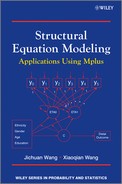Chapter 5
Multi-Group Modeling
The models discussed in previous chapters are all based on a single group or a homogeneous population. Very often, a study may involve more than one group/population. For example, one may want to know whether a measuring instrument of interest is valid for studying different groups/populations. One may also want to know whether the mean values of the factors measured by the instrument or the relationships between the factors differ between different populations/groups. Multi-group CFA model is designed to address such issues. When some causal relationships are tested in more than one group/population, one may wonder whether the same causal relationships hold across different groups/populations. The multi-group SEM model can be used to examine such population heterogeneity.
Multi-group modeling implements simultaneous analyses of multiple groups/populations. The ‘groups’ can be different countries, regions, states, culturally or socio-economically different populations, or any mutually exclusive groups of individuals that can be defined as categorical variables, such as gender, age or ethnic groups, in one's data. Note that the ‘groups’ involved in multi-group modeling are observed or measured. Unobserved groups or unobserved population heterogeneity are considered ‘latent class,’ a topic of mixture modeling that will be discussed in Chapter 6. In addition, the observed groups are considered fixed and the number of groups should be limited. When the number of observed groups is large, assuming they are randomly drawn from a population of groups, the more appropriate approach is multilevel modeling (Goldstein, 1995; Raudenbush and Bryk, 2002).
In this chapter, we will discuss and demonstrate how to use multi-group CFA, multi-group SEM, and multi-group LGMs to test measurement invariance and population heterogeneity.
